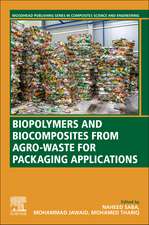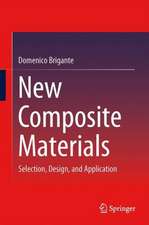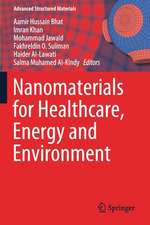Phenolic Polymers Based Composite Materials: Composites Science and Technology
Editat de Mohammad Jawaid, Mohammad Asimen Limba Engleză Hardback – 10 noi 2020
Din seria Composites Science and Technology
- 18%
 Preț: 1001.02 lei
Preț: 1001.02 lei - 18%
 Preț: 951.77 lei
Preț: 951.77 lei - 24%
 Preț: 885.74 lei
Preț: 885.74 lei - 18%
 Preț: 1116.26 lei
Preț: 1116.26 lei - 18%
 Preț: 1012.08 lei
Preț: 1012.08 lei - 18%
 Preț: 1006.55 lei
Preț: 1006.55 lei - 18%
 Preț: 961.23 lei
Preț: 961.23 lei - 18%
 Preț: 950.52 lei
Preț: 950.52 lei - 18%
 Preț: 1109.16 lei
Preț: 1109.16 lei - 24%
 Preț: 844.95 lei
Preț: 844.95 lei - 18%
 Preț: 1112.48 lei
Preț: 1112.48 lei - 18%
 Preț: 952.89 lei
Preț: 952.89 lei - 18%
 Preț: 1383.00 lei
Preț: 1383.00 lei - 18%
 Preț: 1104.43 lei
Preț: 1104.43 lei - 18%
 Preț: 1001.65 lei
Preț: 1001.65 lei - 24%
 Preț: 946.98 lei
Preț: 946.98 lei - 18%
 Preț: 1104.08 lei
Preț: 1104.08 lei - 18%
 Preț: 1117.50 lei
Preț: 1117.50 lei - 18%
 Preț: 1386.17 lei
Preț: 1386.17 lei - 18%
 Preț: 995.34 lei
Preț: 995.34 lei - 18%
 Preț: 1113.89 lei
Preț: 1113.89 lei - 18%
 Preț: 1108.67 lei
Preț: 1108.67 lei - 18%
 Preț: 956.99 lei
Preț: 956.99 lei - 18%
 Preț: 1016.18 lei
Preț: 1016.18 lei - 18%
 Preț: 1389.78 lei
Preț: 1389.78 lei - 18%
 Preț: 1107.41 lei
Preț: 1107.41 lei - 18%
 Preț: 1002.94 lei
Preț: 1002.94 lei - 18%
 Preț: 1111.67 lei
Preț: 1111.67 lei - 18%
 Preț: 953.65 lei
Preț: 953.65 lei - 18%
 Preț: 1006.72 lei
Preț: 1006.72 lei - 18%
 Preț: 1109.62 lei
Preț: 1109.62 lei - 18%
 Preț: 1006.55 lei
Preț: 1006.55 lei -
 Preț: 386.22 lei
Preț: 386.22 lei - 24%
 Preț: 678.66 lei
Preț: 678.66 lei - 18%
 Preț: 1116.71 lei
Preț: 1116.71 lei
Preț: 1109.16 lei
Preț vechi: 1352.63 lei
-18% Nou
Puncte Express: 1664
Preț estimativ în valută:
212.23€ • 221.59$ • 175.65£
212.23€ • 221.59$ • 175.65£
Carte disponibilă
Livrare economică 14-28 martie
Preluare comenzi: 021 569.72.76
Specificații
ISBN-13: 9789811589317
ISBN-10: 9811589313
Pagini: 224
Ilustrații: X, 224 p. 81 illus., 42 illus. in color.
Dimensiuni: 155 x 235 mm
Greutate: 0.45 kg
Ediția:1st ed. 2021
Editura: Springer Nature Singapore
Colecția Springer
Seria Composites Science and Technology
Locul publicării:Singapore, Singapore
ISBN-10: 9811589313
Pagini: 224
Ilustrații: X, 224 p. 81 illus., 42 illus. in color.
Dimensiuni: 155 x 235 mm
Greutate: 0.45 kg
Ediția:1st ed. 2021
Editura: Springer Nature Singapore
Colecția Springer
Seria Composites Science and Technology
Locul publicării:Singapore, Singapore
Cuprins
Phenolic Resin and its Derivatives.- Synthesis of Bio-Phenolic Polymer and its Properties.- Renewable Resource based Phenolic Composites.- Natural Fibres based Phenolic Composites.- Wood Based Phenolic Composites.- Surface Modified Biomaterials based Phenolic Composites.- Synthetic Fibres based Phenolic Composites.- Nanoclay based Phenolic Composites.- Nanofibrillated Cellulose based Phenolic Composites.- Natural Fibres based Phenolic Hybrid Composites.- Renewable Resource-based Bio-Phenolic Composites.- Natural Fibres based Bio-Phenolic Composites.- Wood based Bio-Phenolic Composites.- Surface Modified Biomaterials-based Bio-Phenolic Composites.- Nanoclay based Bio-Phenolic Composites.- Nanofibrillated Cellulose based Bio-Phenolic Composites.- Synthetic Fibres based Bio-Phenolic Hybrid Composites.- Fire Retardant Properties of Bio-Phenolic Hybrid Composites.
Notă biografică
Dr. Mohammad Jawaid is currently working as High Flyer Fellow (Professor) at Biocomposite Technology Laboratory, Institute of Tropical Forestry and Forest Products (INTROP), Universiti Putra Malaysia, Serdang, Selangor, Malaysia, and also Visiting Professor at the Department of Chemical Engineering, College of Engineering, King Saud University, Riyadh, Saudi Arabia, since June 2013. Dr. Mohammad Jawaid received his Ph.D. from Universiti Sains Malaysia, Malaysia. He has more than 10 years of experience in teaching, research, and industries. His area of research interests includes hybrid reinforced/filled polymer composites and advance materials. So far, he has published 37 books, 65 book chapters, more than 350 peer-reviewed international journal papers and several published review papers under top 25 hot articles in science direct during 2013–2018. He also obtained 2 Patents and 5 Copyrights. H-index and citation in Scopus are 51 and 11838, and in Google scholar, H-index and citation are 60 and 16232. He is founding Series Editor of Composite Science and Technology Book, and Springer Proceedings in Materials from Springer Nature. He is also International Advisory Board member of Springer Series on Polymer and Composite Materials. His 5 published review papers under hot cited articles in science direct during 2016–2019. He is reviewer of several high impact ISI journals (90 journals).
Mohammad Asim is currently a Postdoctoral Fellow in the Laboratory of Biocomposite Technology at the Institute of Tropical Forestry and Forest Products (INTROP), Universiti Putra Malaysia. He was born on the 2nd August 1988 in Mau, Uttar Pradesh, India. He completed his bachelor’s degree in forestry from C.S. Azad University of Agriculture and Technology, Kanpur, India, in 2011. Afterward, he continued his study and obtained his M.Sc. in wood science and technology from Forest Research Institute, Dehradun, India, in 2013, and finally Ph.D. degree in the field of biocomposite technology from Universiti Putra Malaysia in 2017. His main research areas aretreatment and modification of natural fibres, hybrid reinforced/filled polymer composites, advance materials: nanoclay/fire retardant, lignocellulosic reinforced/filled polymer composites, nanocomposites and nanocellulose fibres, thermosets and thermoplastics. Dr. Asim has published more than 35 international journal papers, 3 review papers, 4 book chapters and 4 conference proceedings.
Textul de pe ultima copertă
This book contains recent research on phenolic resin and its composite materials. The book covers all types of wood composites, natural fibres and synthetic fibres reinforced composites. It discusses various properties of phenolic composites and presents comparative study with other polymer composites for prospective applications. The chapters in the book present an up-to-date information on the subject area of polymer and composite-based information by prominent researchers in academia and industry as well as government/private research laboratories across the world. The book serves as a holistic reference source for university and college faculties, professionals, postdoctoral research fellows, undergraduate/graduate students, and research and science officers working in the area of polymer science, non-forest products utilization, natural fibres and biomass materials.
Caracteristici
Serves as a holistic reference of phenolic resin and its composite materials Covers all types of wood composites, natural fibers, and synthetic fibers reinforced composites Discusses various properties of phenolic composites and presents comparative study with other polymer composites for prospective applications


























